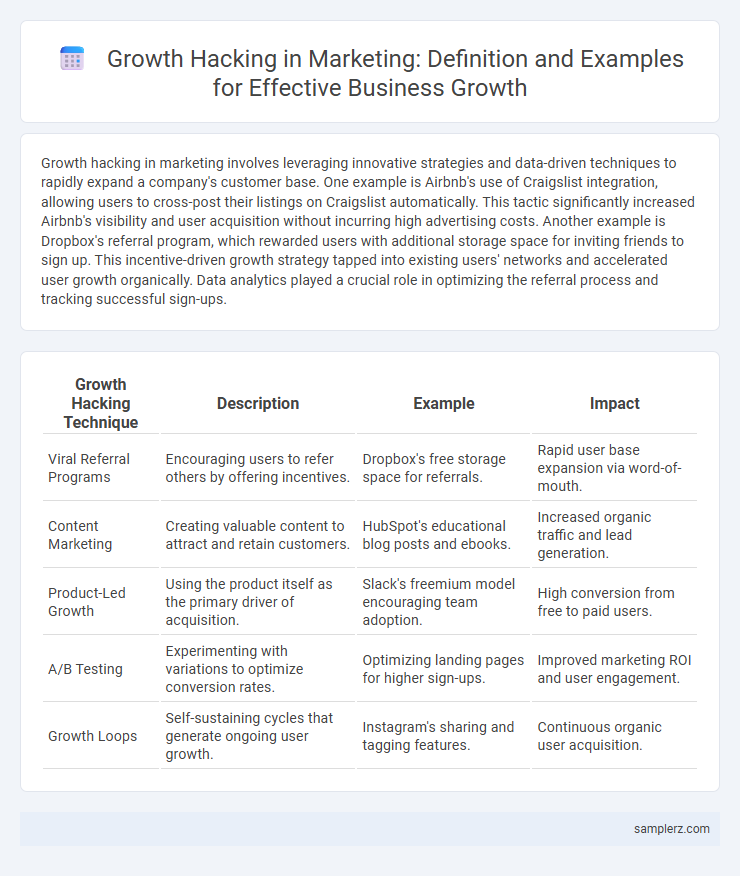Growth hacking in marketing involves leveraging innovative strategies and data-driven techniques to rapidly expand a company's customer base. One example is Airbnb's use of Craigslist integration, allowing users to cross-post their listings on Craigslist automatically. This tactic significantly increased Airbnb's visibility and user acquisition without incurring high advertising costs. Another example is Dropbox's referral program, which rewarded users with additional storage space for inviting friends to sign up. This incentive-driven growth strategy tapped into existing users' networks and accelerated user growth organically. Data analytics played a crucial role in optimizing the referral process and tracking successful sign-ups.
Table of Comparison
| Growth Hacking Technique | Description | Example | Impact |
|---|---|---|---|
| Viral Referral Programs | Encouraging users to refer others by offering incentives. | Dropbox's free storage space for referrals. | Rapid user base expansion via word-of-mouth. |
| Content Marketing | Creating valuable content to attract and retain customers. | HubSpot's educational blog posts and ebooks. | Increased organic traffic and lead generation. |
| Product-Led Growth | Using the product itself as the primary driver of acquisition. | Slack's freemium model encouraging team adoption. | High conversion from free to paid users. |
| A/B Testing | Experimenting with variations to optimize conversion rates. | Optimizing landing pages for higher sign-ups. | Improved marketing ROI and user engagement. |
| Growth Loops | Self-sustaining cycles that generate ongoing user growth. | Instagram's sharing and tagging features. | Continuous organic user acquisition. |
Innovative Social Media Campaigns that Went Viral
Innovative social media campaigns like Spotify's "Wrapped" have driven exponential user engagement by leveraging personalized data stories that encourage sharing and competition among users. Airbnb's use of Instagram's visual storytelling to showcase unique travel experiences transformed user-generated content into a viral marketing powerhouse, boosting brand visibility and bookings. The ALS Ice Bucket Challenge exemplifies viral growth hacking by combining a compelling cause with social media's sharing mechanics, generating over $115 million in donations and widespread awareness in just a few weeks.
Leveraging Influencer Partnerships for Rapid Growth
Brands leveraging influencer partnerships achieve rapid growth by tapping into influencers' established audiences and authentic engagement. Utilizing targeted micro-influencers increases brand visibility and drives highly relevant traffic, leading to faster customer acquisition and higher conversion rates. Data-driven influencer selection and performance tracking optimize campaign ROI and fuel scalable marketing growth.
Referral Programs: Turning Customers into Marketers
Referral programs leverage existing customers to drive exponential growth by incentivizing them to promote products or services within their networks. Companies like Dropbox and Airbnb have successfully implemented referral campaigns that reward users with benefits such as free storage or credits, leading to viral growth and increased customer acquisition at low cost. These programs optimize user engagement and trust, transforming customers into powerful brand advocates while significantly lowering marketing expenses.
Creative Use of User-Generated Content
Leveraging user-generated content (UGC) in marketing campaigns can significantly boost brand engagement and authenticity by showcasing real customer experiences. Viral contests encouraging customers to share photos or stories related to the brand amplify reach organically while simultaneously generating a wealth of relatable content. Platforms like Instagram and TikTok are ideal for distributing UGC, driving exponential growth through peer-to-peer recommendations and social proof.
Data-Driven Personalization Strategies
Data-driven personalization strategies in marketing leverage customer data analytics to tailor content, offers, and experiences to individual preferences, significantly boosting engagement and conversion rates. Companies like Netflix analyze billions of data points to recommend personalized content, driving user retention and growth. Implementing machine learning algorithms to segment audiences and predict behavior enables marketers to optimize campaigns in real-time, enhancing ROI and accelerating growth.
A/B Testing for Explosive Conversion Rates
A/B testing leverages data-driven experimentation to optimize marketing campaigns by comparing two versions of a webpage or ad to identify which yields higher conversion rates. Companies like Airbnb and Amazon have used A/B testing to refine user experience and personalized content, resulting in explosive growth and increased customer engagement. Continuous iteration through A/B testing uncovers actionable insights that drive significant improvements in click-through rates and overall ROI.
Harnessing Scarcity and Urgency in Promotions
Harnessing scarcity and urgency in promotions drives rapid customer action by leveraging limited-time offers and exclusive deals to create a fear of missing out (FOMO). Techniques like flash sales, countdown timers, and limited stock alerts increase conversion rates by tapping into psychological triggers that compel immediate purchases. Brands such as Amazon and Booking.com effectively use these strategies to boost sales velocity and enhance customer engagement.
Early Access and Beta Launch Tactics
Early access and beta launch tactics accelerate user acquisition by creating exclusivity and fostering community engagement before full product release. Companies like Dropbox leveraged beta invites to generate buzz and collect valuable user feedback, driving viral growth through referral incentives. Offering limited early access generates anticipation while refining product features based on real user data enhances market fit and long-term retention.
Automated Email Marketing Growth Hacks
Automated email marketing growth hacks leverage segmentation and personalized content to increase open rates and conversions, using behavior-triggered campaigns and dynamic product recommendations. Employing A/B testing on subject lines and send times optimizes engagement, while integrating AI-driven analytics enhances predictive targeting and customer retention. Tools like Mailchimp and HubSpot streamline automation, enabling scalable, data-driven growth strategies that maximize ROI in marketing campaigns.
Gamification Techniques that Boost Engagement
Gamification techniques in marketing leverage game design elements such as points, badges, and leaderboards to boost customer engagement and drive user interaction. For example, Starbucks Rewards uses a tiered points system encouraging repeat purchases by rewarding customers with free items and exclusive perks. Implementing these strategies increases customer loyalty and enhances user experience, ultimately accelerating business growth.

example of growth hacking in marketing Infographic
 samplerz.com
samplerz.com